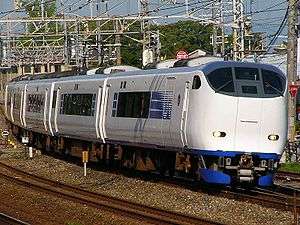Haruka (train)
|
A JR West 281 series EMU on a Haruka service in August 2004 | |
| Overview | |
|---|---|
| Service type |
Airport rail link (Limited express) |
| Locale | Tokaido Main Line, Osaka Loop Line, Hanwa Line, Kansai Airport Line |
| First service | 4 September 1994 |
| Current operator(s) | JR West |
| Route | |
| Start | Maibara |
| End | Kansai Airport |
| Service frequency | 30 return workings daily |
| On-board services | |
| Class(es) | Green/standard |
| Technical | |
| Rolling stock | 281 series EMUs |
| Track gauge | 1,067 mm (3 ft 6 in) |
| Electrification | 1,500 V DC overhead |
| Operating speed | 130 km/h (80 mph)[1] |
The Haruka (はるか Haruka), is a limited express train service, connecting Maibara via Kyoto Station to Kansai Airport Station in Osaka Prefecture, Japan. It is operated by the West Japan Railway Company (JR West).
Operations
There are 60 Haruka train services per day, numbered 1 to 60; odd-numbered trains run south (toward the airport) and even-numbered trains run north (away from the airport). They operate every half hour during the daytime and early evening. The typical travel time between Kyoto Station and the airport is 75 minutes for southbound trains and 73 minutes for northbound trains.[2]
Station stops
The Haruka primarily operates between Kyoto Station and Kansai Airport Station, with stops at Shin-Ōsaka Station and Tennōji Station in Osaka City. Some trains make additional stops (stations in italics in list below).[2]
The train travels over the Umeda Freight Line which bypasses Osaka Station when it runs from the Tōkaidō Main Line to Osaka Loop Line and vice versa. Therefore, it does not stop at Osaka Station.
| Line | Station | Transfers |
|---|---|---|
| Tōkaidō (Biwako) |
Maibara | Tōkaidō Shinkansen, Tōkaidō Main Line, Hokuriku Main Line, Ohmi Railway Main Line |
| Hikone | Ohmi Railway Main Line | |
| Ōmi-Hachiman | Ohmi Railway Yōkaichi Line | |
| Yasu | ||
| Moriyama | ||
| Kusatsu | Kusatsu Line | |
| Ishiyama | Keihan Ishiyama Sakamoto Line | |
| Ōtsu | ||
| Yamashina | Kosei Line, Keihan Ishiyama Sakamoto Line, Subway Tōzai Line | |
| Kyoto | Tōkaidō Shinkansen, Sanin Main Line, Nara Line Kintetsu Kyoto Line, Subway Karasuma Line | |
| Tōkaidō (JR Kyoto) | ||
| Takatsuki | ||
| Shin-Ōsaka | Tōkaidō Shinkansen, Sanyō Shinkansen, Subway Midōsuji Line | |
| Tōkaidō (freight branch) Osaka Loop | ||
| Tennōji | Yamatoji Line, Subway Midōsuji and Tanimachi Lines, Kintetsu Minami Osaka Line | |
| Hanwa | ||
| Izumi-Fuchū | ||
| Hineno | Hanwa Line for Wakayama | |
| Kansai Airport | ||
| Kansai Airport |
Rolling stock
Haruka services are operated by a dedicated fleet of 281 series EMUs formed in 6- or 9-car formations. Each formation includes one Green (first class) car (as car No. 1).[1]
Formations
6-car formations
6-car formations are arranged as shown below, with car 1 at the Maibara/Kyoto end.[3][4]
| Car No. | 1 | 2 | 3 | 4 | 5 | 6 |
|---|---|---|---|---|---|---|
| Numbering | KuRo 280 | MoHa 281 | SaHa 281 | SaHa 281 | MoHa 281 | KuHa 281 |
| Accommodation | Green | Reserved | Reserved | Reserved | Non-reserved | Non-reserved |
| Facilities | Toilet | Vending machine | Wheelchair space / Toilet | Toilet | Vending machine |
All cars are no-smoking.[3]
9-car formations
9-car formations are arranged as shown below, with car 1 at the Kyoto end.[3][4]
| Car No. | 1 | 2 | 3 | 4 | 5 | 6 | 7 | 8 | 9 | |
|---|---|---|---|---|---|---|---|---|---|---|
| Numbering | KuRo 280 | MoHa 281 | SaHa 281 | SaHa 281 | MoHa 281 | KuHa 281 | KuHa 280 | SaHa 281 | KuHa 281 | |
| Accommodation | Green | Reserved | Reserved | Non-reserved | Non-reserved | Non-reserved | Reserved | Reserved | Reserved | |
| Facilities | Toilet | Vending machine | Wheelchair space / Toilet | Toilet | Vending machine | Toilet | Toilet | Vending machine |
All cars are no-smoking.[3]
Ticketing
As a limited express service, Haruka travel requires both a fare ticket (乗車券 jōshaken) and a limited express ticket (特急券 tokkyūken) – see train tickets in Japan. The ICOCA card can be used as a fare ticket (for passing the ticket gate) for non-reserved travel, with the limited express ticket purchased from the conductor on board the train. Japan Rail Pass holders can ride Haruka services free of charge.
A free public Wi-Fi service is provided in the train.[5]
History
The Haruka service was inaugurated on 4 September 1994 using 3-car 281 series EMUs.[4]
6-car 281 series sets were introduced from 2 April 1995, and 9-car (6+3-car) formations were introduced from 14 July 1995.[4]
Non-reserved cars were introduced from 1 December 1998.[4]
The smoking areas were abolished from the start of the 18 March 2007 timetable revision.[4]
References
- 1 2 JR新幹線&特急列車ファイル [JR Shinkansen & Limited Express Train File] (in Japanese). Japan: Kotsu Shimbunsha. 2008. ISBN 978-4-330-00608-6.
- 1 2 JR Timetable March 2012 issue. p.112
- 1 2 3 4 JR Timetable March 2012 issue. p.1006
- 1 2 3 4 5 6 JR電車編成表 2012夏 [JR EMU Formations - Summer 2012] (in Japanese). Japan: Kotsu Shimbunsha. May 2012. p. 159. ISBN 978-4-330-28612-9.
- ↑ "JR-WEST Free Wi-Fi Service". West Japan Railway Company. Retrieved 2016-01-20.
External links
- Limited Express Haruka 281 series (Japanese)
- Haruka train service timetable, PDF

.svg.png)